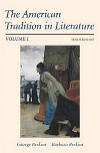When Herman Melville published his celebrated novel on the whaling industry, he dedicated Moby Dick to "the author of the Scarlet Letter." Nathaniel Hawthorne and Herman Melville were not only friends and correspondents, but both had selected the problem of evil and the nature of humanity as common themes for their work, and like Henry David Thoreau, another Massachusetts observer of the human condition, they both challenged some of the easy assumptions of their contemporaries about the authority of the state and the individual's responsibilities to it. Melville's formative years, 1841 - 1845, followed the death of his bankrupt father, when, at 19, Melville signed on as a merchant seaman and set sail for Liverpool, England. He returned home briefly to teach school, but almost immediately shipped out again for the South Pacific where he and a friend deserted their whaler for a short sojourn in the Marquesas Islands. After a month among the Taipei cannibals, the two secured work on another whaler bound for the Sandwich (Hawaiian) Islands, where Melville enlisted in the United States Navy. Fourteen months later, he returned to Boston where he married into a prominent New England family and began writing the works that would place him in the circle of the most respected American writers of the nineteenth century. Typee (1846), a fictionalized account of his experiences in the South Pacific, brought him immediate acclaim as a young writer. He followed it with two sequels, Mardi (1847) and Omoo (1849), both of which brought only mixed responses from readers. What he might have lost in readership from those more philosophical works, he restored, however, in his next two novels of high adventure that followed immediately, Redburn (1849) and White-Jacket (1850). Then, in 1851, from Arrowhead, a farm just outside Pittsfield, Massachusetts, he published Moby Dick. Moby Dick was the first major novel to examine the North American whaling industry. Chapter after chapter, it is filled with the almost tedious business of the sea hunt for the oceanic leviathan. Like his last work, Billy Budd, Sailor, however, Moby Dick is an allegorical novel, symbolizing the eternal conflict of humanity against the powers of nature. Ahab, the manic captain of the Pequod, pursues his quest for the whale, spurred on by a colossal arrogance to the destruction of the entire community of his sailors. While the book never sold well in his lifetime, it was to be his masterpiece. Melville would write additional novels-- Pierre, or The Ambiguities, a novel of incest (1852), Israel Potter (1855), and The Confidence Man (1857). Following a trip to the Holy Land, he returned to write Clarel (1867), a long and uneven spiritual poem based upon his excursion to the Middle East. Among his other works are occasional critical essays, collections of short stories, The Piazza Tales (1856), and three additional volumes of poems, Battle Pieces and Aspects of the War (1866), John Marr and Other Sailors (1888) and Timoleon (1891). His final work, Billy Budd, Sailor, left unpublished at his death, rivals Moby Dick today for its ethical and moral power. Despite the proliferation of work throughout his life, Melville's last years were spent in literary obscurity and marginal financial circumstances. Moreover, when a fire at his publishers destroyed the plates to all of his works, they were not reprinted because of the dwindling returns from his earlier printings. In 1866, he left Arrowhead for a job as a lowly customs clerk on the wharfs in New York City. He died on September 28, 1891, while still preparing his manuscript of Billy Budd for publication. |



 2003 McGraw-Hill Higher Education
2003 McGraw-Hill Higher Education